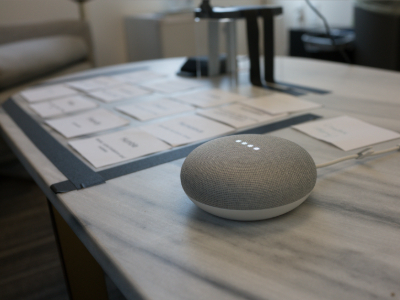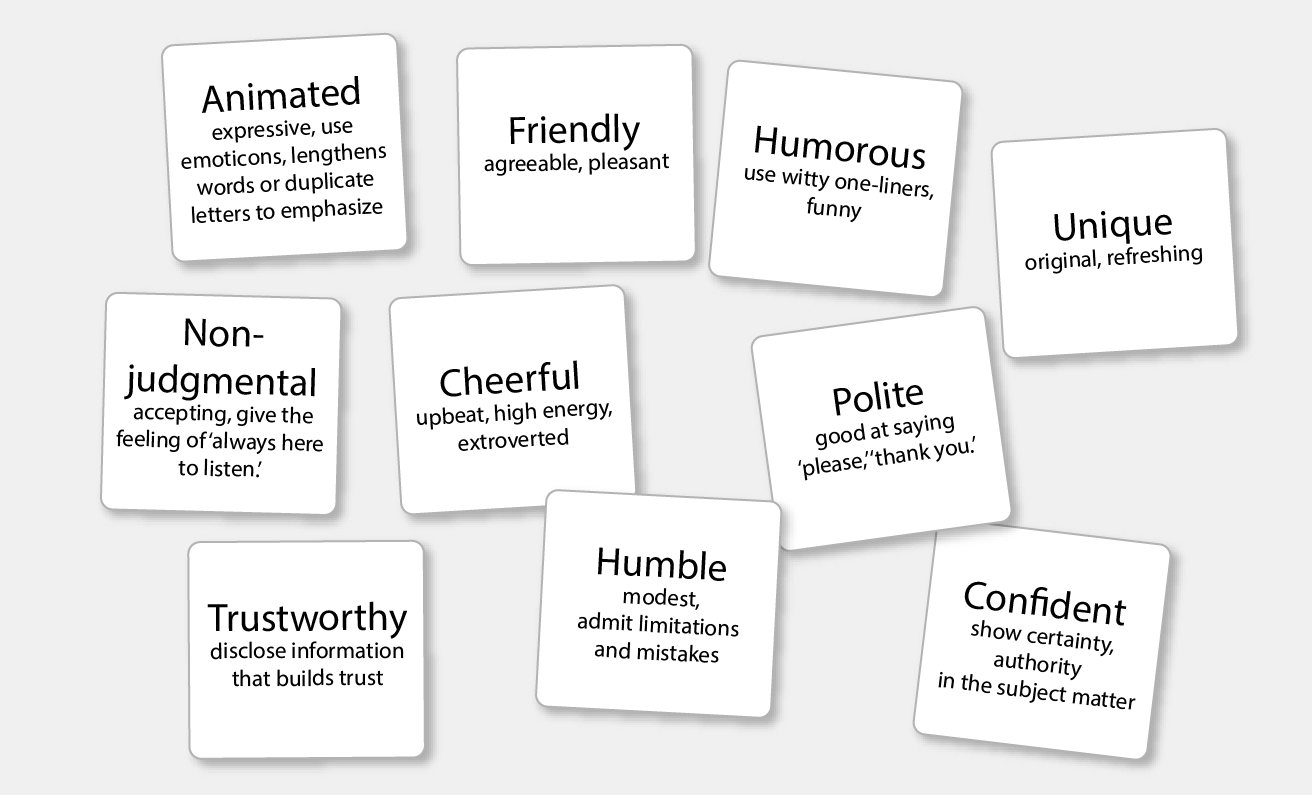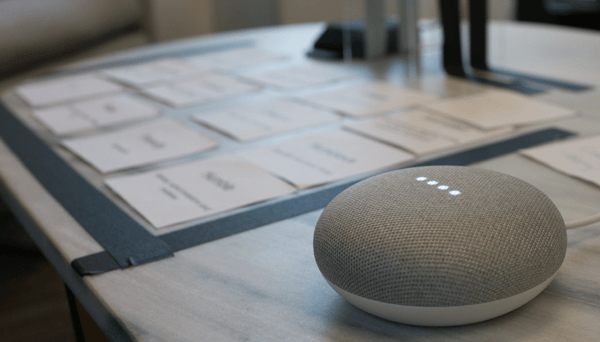Digital assistants go by many names - chatbot, virtual assistant, conversation agent—to name a few. They live in differe...
Does Your Digital Assistant Meet User Expectations for Personality?

Posted by AnswerLab Research on Feb 12, 2019
Our recent research with smart speaker owners and chatbot users provided a look into what makes a digital assistant successful. In a nationwide diary study, participants completed daily tasks, sharing their impressions and unmet needs based on interactions with several chatbots and smart speaker voice applications. Now, we’re looking at the role of personality in these assistants and what users consider desirable (and undesirable) traits based on industry and capabilities.
Much has been written and discussed on the role of personality in digital assistants, but much of this material fails to go to the source to find out what people really want when it comes to personality and their digital assistants. In the second phase of AnswerLab’s recent digital assistant study, we conducted in-person in-depth interviews with a select group of participants from the nationwide diary to explore digital assistants’ personality from the user’s perspective. Our participants interacted with assistants from brands including American Express, Bank of America, Domino’s, and eBay to see a wide variety of industry applications. We gave participants a list of 11 positive personality traits along with a short description for each.

Participants ranked the top, must-have qualities they want in a digital assistant, for the banking, retail, and healthcare tasks respectively, as well as any undesired qualities. Using their experiences shared in the diary study, they elaborated on each wanted and unwanted trait.
To dig deeper into the characteristics of the relationship that participants want to have with their digital assistant, we also asked them to imagine a real-life character to represent the chatbot or voice assistant. The character could be a real person (like a friend), a character from media, books, or cartoons, or a celebrity. When some had trouble coming up with a specific name, they were told that the focus was on why the person would make a good candidate for the job, not who she/he is.
“Who would you want to play the digital assistant for digital payment-related tasks? What about financial investment types tasks, if any different at all?”
The results revealed insights about the traits that users want their digital assistant to display, and why, for each industry.
What does personality mean for a digital assistant?
When we talk about brand personality, brands are often treated as people. But how does personality for people differ from personality for bots?
The folk understanding of personality refers to the idea that a person has a consistent way of behaving. However, over the history of personality research, psychologists consistently fail to find evidence that behavioral stability exists in people. As the research behind it was explored in a NPR podcast, every person can change how she or he acts or feels depending on the situation. Inconsistency is the rule, not the exception.
While people themselves are not consistent, they do expect consistency in the personality of their digital assistants. A digital assistant, whether over voice or text, is a channel after all; establishing a consistent brand experience across channels is important for building customer trust and loyalty. When asked to rank order the must-have personality traits for each industry, we found consistency in user expectations by industry.

Key findings for personality traits in digital assistants
Trust is a must
Across industries, everyone chose trustworthiness as a must-have quality for digital assistants. For financial services, trust for a digital assistant means ensuring high security and accuracy of information. For healthcare, trust means communicating evidence-based confidence in the subject matter. As for retail, trust means proactively disclosing the criteria for personalized recommendations.

“I need to know why the recommended item is the best, e.g., based on all available options. That makes [the retail digital assistant] trustworthy.”
It is important to note that trust is certainly, more than just a personality trait. Trust summarizes the entire ideal experience between a person and her digital assistant. In a sense, everything from improving value, effectiveness, and engagement are all in service of building trust between the user and the assistant.
Read more about trust in our full report: Elements of a Successful Digital Assistant and How to Apply Them
Business first, personality second
Elements of engagement such as personality must be added after you’ve hit the threshold for value and effectiveness. A digital assistant must first deliver on the value dimension by adding value to users’ existing ways of interacting with a brand. But, providing added value is only relevant if it can effectively execute on those expectations by being flexible in interpreting questions, keeping track of conversation, and giving accurate, on-topic answers. A successful deployment of personality boils down to balancing it with effectiveness, in addition to the context of use, such as industry differences. When the digital assistant does not meet user expectation in terms of functionality and added value, being fun and engaging can hurt the experience and cause mistrust. See user examples on p.33 - 37 of the full report.
In today’s experience, effectiveness without displaying any signs of personality didn’t damage the experience. But, effectiveness combined with engagement exhilarated the participants.
‘Humor’ undermines credibility for financial services and healthcare assistants

“Google (Assistant) is friendly but not humorous. Being friendly, personable is not the same as being humorous. If I want humor, I ask Google for a joke. There is a time or place for jokes.”
Humor, defined as being funny, using witty one-liners, was the quality that everyone chose as not desirable for an assistant that handles their healthcare or financial tasks. For example, participants did not want a digital assistant that makes investment decisions for them to be animated at all. They wanted “pure information” from these digital assistants and did not want them to joke about their health or financial status.
That being said, a few commented that humor, when done in the right context, is a sign of intelligence. Or, humor is permissible if the assistant has known them for a long period of time and earned their trust.
“I can see humor comes into play when the person is actively annoying to the bot. In video games, when you click on an avatar 50 times just to get a rise out of it, sometimes the avatar says ‘Hey, why are you clicking on me?!’ That’s smart and funny.”
‘Confident’ and ‘Humble’ financial services assistant

“Not everyone has financial literacy. Even if I ask silly questions, the banking assistant should be humble and answer them without judgment.”
Everyone chose confident as a must-have quality for the financial services assistant. This is not surprising given the effectiveness expectations of all digital assistants. At the same time, many chose humble to be a defining trait as well. The standard error message “I can’t do that right now” from Google Home was considered better than Alexa saying “I’m not sure if I get that.” The former was seen as humble and informational. Many preferred the digital assistants to be humble by way of handing off tasks that they are not 100% certain of the answer to other customer service platforms.
‘Unique’ retail assistant

“Shopping to me is a very personal experience. If we are going to do it through a bot, it better offers me something more unique than app or web.”
For both retail chatbots and voice assistants, participants expected more humor than they did from financial service and healthcare assistants. Interestingly, many chose ‘unique’ to be a defining trait for their retail assistant. Participants think of a unique retail assistant as delivering a highly personalized shopping experience (unique price, deals or products tailored to their taste profiles). They had higher expectations for shopping from a bot than through other traditional channels (app, web, or in-store). This goes back to the first requirement of delivering added value for all digital assistants.
Brands should design around these personality components
User feedback reflected the following components of personality for digital assistants: sound design, expressions of personality, word choice and tone, and gender.
Choice of Voice
In addition to word choice, the acoustic characteristics of voice are key for forming voice personality impressions. Studies showed that whenever we hear a new voice we automatically form a ‘first impression’ of the voice owner’s personality, such as authority and maturity. This bias for impression is so robust that in a recent study, 500 listeners showed that they could hear differences in how trustworthy the speaker is with as little as a single word ‘hello.’ Hellos rated high in trustworthiness appeared to start with a high intonation, with a slight decrease in the middle of the utterance, and a strong rise finish.
In our study, when participants entered a branded voice app with a custom voice distinct from Google Assistant or Alexa’s voice, they immediately noticed the difference. They liked the distinction for helping them understand where they were in the path, e.g., from Google Assistant to eBay’s app on Google, in the quote below.
“The changing voices give each program its own unique personality, rather than coming out of the Google Assistant’s voice. I know my wife’s voice, that voice is Google, this voice is eBay. It gave me something to ‘look at.’ I’m looking at the eBay’s voice, not their logo. Voice is logo.”
Expressions of Personality
We surveyed the personalities of Alexa, Microsoft’s Cortana, Google Voice Assistant, and Siri. As expected, they were all created to be ‘polite, friendly and helpful,’ as these traits are basic requirements for an assistant that needs to work for a large audience. A few other universal basic requirements of an assistant included being impartial and enthusiastic.
In addition to the universal traits, subtle differences exist. For example:
![]()
Users experience Alexa’s personality through its telling jokes and Easter Eggs.
![]() Siri was perceived as friendly, but also with an edge and has a sassy side.¹
Siri was perceived as friendly, but also with an edge and has a sassy side.¹
![]() Google Assistant’s personality team has publicly emphasized the need for personality, in that “having no personality was actually a personality in itself.” They described Google Assistant as a “cool librarian.” Users often perceived Google Assistant as being conversational, approachable, and inviting.
Google Assistant’s personality team has publicly emphasized the need for personality, in that “having no personality was actually a personality in itself.” They described Google Assistant as a “cool librarian.” Users often perceived Google Assistant as being conversational, approachable, and inviting.
![]() Microsoft devoted serious efforts to crafting Cortana’s personality. The choice to make Cortana not sound too human was deliberate, so as to not invite unrealistic expectations, as we discussed earlier. In the design process, Microsoft talked to users about their ideal personal assistant worldwide, including conducting cultural testing.²
Microsoft devoted serious efforts to crafting Cortana’s personality. The choice to make Cortana not sound too human was deliberate, so as to not invite unrealistic expectations, as we discussed earlier. In the design process, Microsoft talked to users about their ideal personal assistant worldwide, including conducting cultural testing.²
Word Choice and Tone
 Unlike the various things that express people’s traits, when it comes to digital assistants, there are limited tools for expressing personalities:
Unlike the various things that express people’s traits, when it comes to digital assistants, there are limited tools for expressing personalities:
-
word choice and the voice itself if voice-activated
-
word choice alone if text-activated
Word choice is intimately bound up with the tone it conveys. The tone of a written or verbal response is a bit of a mysterious thing to describe, but we all know it when we feel it. The tone refers to the feel of the response: Is it informal or formal, does it feel approachable or cold, easy to grasp or complex? The factors that influence our perception of tone are varied and subtle, yet are quite noticeable to participants. For example, in the greeting message received from Capital One’s chatbot Eno, the participant marked on the paper printout what exactly conveyed the tone that she liked in an interaction she had with Eno.
“'First thing first'…that is conversational. Eno is giving me clear instructions without using vernaculars that felt not human. If it says ‘Here is the first step,’ it would have a transactional, stiff feeling.”
Gender
![]() Whether to give a digital assistant the female or male gender is a popular topic this year. As we discussed previously about our ingrained need to anthropomorphize, the choice of gender for a digital assistant invites questions and concerns. For example, in the top search result for ‘Why is the digital assistant’s voice always female', the author urged us to challenge the stereotypical gender roles as represented by the predominantly female-voiced digital assistants. Indeed, there is a rich history of the role of women in domestic labor, where jobs such as personal assistants were frequently relegated to women.
Whether to give a digital assistant the female or male gender is a popular topic this year. As we discussed previously about our ingrained need to anthropomorphize, the choice of gender for a digital assistant invites questions and concerns. For example, in the top search result for ‘Why is the digital assistant’s voice always female', the author urged us to challenge the stereotypical gender roles as represented by the predominantly female-voiced digital assistants. Indeed, there is a rich history of the role of women in domestic labor, where jobs such as personal assistants were frequently relegated to women.
Female-voiced digital assistants trigger that association. Yet, consumer research in digital assistants showed that cross-culturally, it is much easier to find a female voice that has mass appeal than a male voice. To reconcile the public’s needs for a gendered voice with our responsibility to not encourage gender binary expressions that are ever-changing and disappearing in the western society, a simpler solution in the near term is to provide options. Siri and Google Assistant have both offered the option to switch to male voice options, in addition to having female voice only.
• • • •
When designing for digital assistants, it’s crucial to design with these components in mind, shaping each piece both to reflect your brand and to reinforce the value and effectiveness of your assistant. Consider how users perceive personality traits based on the job to be done, your industry, and audience. And as always, do research on the perceived personality of your digital assistant. One methodological note on conducting perceived personality research for brands - as with all social interactions, many factors such as the distribution of participants’ personalities, gender, work background, expectations will influence their judgment of the personality of the digital assistants. For example, an introvert user might find it easier to interact with a low pitch smart speaker based assistant than a high pitch one, compared with an extrovert user. Make sure to know your audience as well as possible, and aim for a large sample size to minimize such effects.
For more information on designing effective digital assistants, download the full report: Elements of a Successful Digital Assistant and How to Apply Them.
• • • •
¹ Fowler, G. A. “Are Smartphones Becoming Smart Alecks?” WSJ. October 15, 2011.
² Pearl, C. (2016). Designing Voice User Interfaces: Principles of Conversational Experiences. " O'Reilly Media, Inc
AnswerLab Research
The AnswerLab research team collaborates on articles to bring you the latest UX trends and best practices.related insights
Get the insights newsletter
Unlock business growth with insights from our monthly newsletter. Join an exclusive community of UX, CX, and Product leaders who leverage actionable resources to create impactful brand experiences.